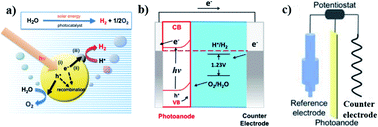Recent developments in carbon nitride based films for photoelectrochemical water splitting
Abstract
As an emerging star semiconductor for photoelectrochemical (PEC) cells, metal-free graphitic carbon nitride (g-CN) has generally attracted research attention from the community that develops inorganic semiconductor photoelectrodes due to its merits, namely an appropriate bandgap, abundant composition elements, good thermal stability and non-toxicity. The development of g-CN based photoelectrodes is still in its initial stage. The key step is to fabricate high-quality g-CN films, but this is restricted by limited production methods. Furthermore, pristine g-CN photoelectrodes exhibit low photocurrent density which cannot meet the demands of commercial application. Multiple modification strategies have been reported, including doping, monomer modification, cocatalysts and composite photoelectrodes, but a single modification method is unlikely to substantially improve the photocurrent density of g-CN photoelectrodes. Therefore, a multiple combination strategy may be an efficient approach. Hundreds of studies concerned with g-CN based PEC devices are reported each year, but there is a lack of comprehensive reviews to well summarize the research. It is imperative to provide researchers with a thorough understanding of the most recent progress in this field. In this review, we present the basic knowledge on PEC cells, our new perspective on the structure of g-CN, the achievements and deficiencies in the development of g-CN based photoelectrodes and some of our suggestions and new ideas about g-CN based films for PEC devices in the future.

- This article is part of the themed collection: Sustainable Energy and Fuels Recent Review Articles


 Please wait while we load your content...
Please wait while we load your content...